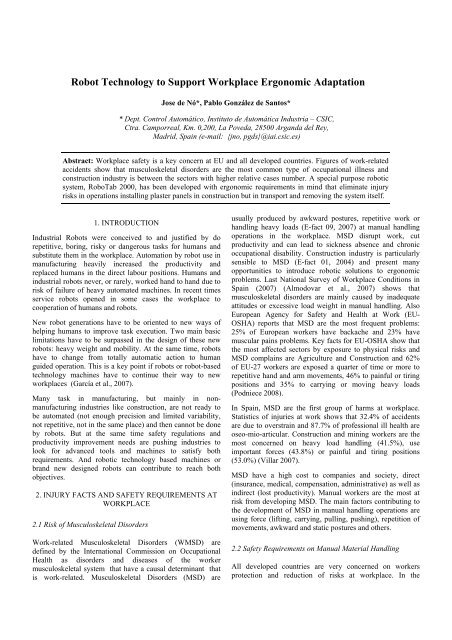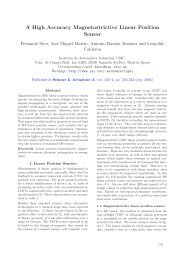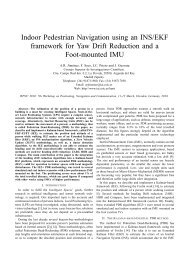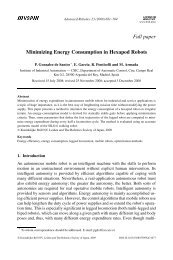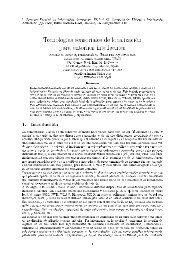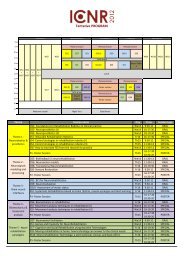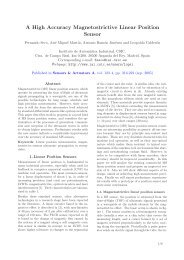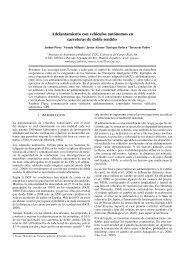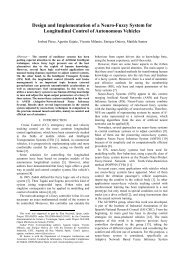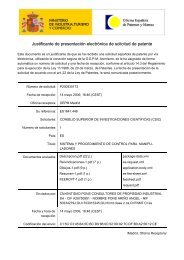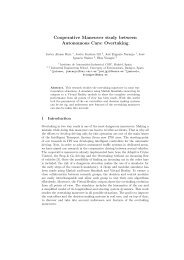Robot Technology to Support Workplace Ergonomic Adaptation
Robot Technology to Support Workplace Ergonomic Adaptation
Robot Technology to Support Workplace Ergonomic Adaptation
You also want an ePaper? Increase the reach of your titles
YUMPU automatically turns print PDFs into web optimized ePapers that Google loves.
<strong>Robot</strong> <strong>Technology</strong> <strong>to</strong> <strong>Support</strong> <strong>Workplace</strong> <strong>Ergonomic</strong> <strong>Adaptation</strong><br />
Jose de Nó*, Pablo González de San<strong>to</strong>s*<br />
* Dept. Control Au<strong>to</strong>mático, Institu<strong>to</strong> de Au<strong>to</strong>mática Industria – CSIC,<br />
Ctra. Camporreal, Km. 0,200, La Poveda, 28500 Arganda del Rey,<br />
Madrid, Spain (e-mail: {jno, pgds}@iai.csic.es)<br />
Abstract: <strong>Workplace</strong> safety is a key concern at EU and all developed countries. Figures of work-related<br />
accidents show that musculoskeletal disorders are the most common type of occupational illness and<br />
construction industry is between the sec<strong>to</strong>rs with higher relative cases number. A special purpose robotic<br />
system, RoboTab 2000, has been developed with ergonomic requirements in mind that eliminate injury<br />
risks in operations installing plaster panels in construction but in transport and removing the system itself.<br />
1. INTRODUCTION<br />
Industrial <strong>Robot</strong>s were conceived <strong>to</strong> and justified by do<br />
repetitive, boring, risky or dangerous tasks for humans and<br />
substitute them in the workplace. Au<strong>to</strong>mation by robot use in<br />
manufacturing heavily increased the productivity and<br />
replaced humans in the direct labour positions. Humans and<br />
industrial robots never, or rarely, worked hand <strong>to</strong> hand due <strong>to</strong><br />
risk of failure of heavy au<strong>to</strong>mated machines. In recent times<br />
service robots opened in some cases the workplace <strong>to</strong><br />
cooperation of humans and robots.<br />
New robot generations have <strong>to</strong> be oriented <strong>to</strong> new ways of<br />
helping humans <strong>to</strong> improve task execution. Two main basic<br />
limitations have <strong>to</strong> be surpassed in the design of these new<br />
robots: heavy weight and mobility. At the same time, robots<br />
have <strong>to</strong> change from <strong>to</strong>tally au<strong>to</strong>matic action <strong>to</strong> human<br />
guided operation. This is a key point if robots or robot-based<br />
technology machines have <strong>to</strong> continue their way <strong>to</strong> new<br />
workplaces (García et al., 2007).<br />
Many task in manufacturing, but mainly in nonmanufacturing<br />
industries like construction, are not ready <strong>to</strong><br />
be au<strong>to</strong>mated (not enough precision and limited variability,<br />
not repetitive, not in the same place) and then cannot be done<br />
by robots. But at the same time safety regulations and<br />
productivity improvement needs are pushing industries <strong>to</strong><br />
look for advanced <strong>to</strong>ols and machines <strong>to</strong> satisfy both<br />
requirements. And robotic technology based machines or<br />
brand new designed robots can contribute <strong>to</strong> reach both<br />
objectives.<br />
2. INJURY FACTS AND SAFETY REQUIREMENTS AT<br />
WORKPLACE<br />
2.1 Risk of Musculoskeletal Disorders<br />
Work-related Musculoskeletal Disorders (WMSD) are<br />
defined by the International Commission on Occupational<br />
Health as disorders and diseases of the worker<br />
musculoskeletal system that have a causal determinant that<br />
is work-related. Musculoskeletal Disorders (MSD) are<br />
usually produced by awkward postures, repetitive work or<br />
handling heavy loads (E-fact 09, 2007) at manual handling<br />
operations in the workplace. MSD disrupt work, cut<br />
productivity and can lead <strong>to</strong> sickness absence and chronic<br />
occupational disability. Construction industry is particularly<br />
sensible <strong>to</strong> MSD (E-fact 01, 2004) and present many<br />
opportunities <strong>to</strong> introduce robotic solutions <strong>to</strong> ergonomic<br />
problems. Last National Survey of <strong>Workplace</strong> Conditions in<br />
Spain (2007) (Almodovar et al., 2007) shows that<br />
musculoskeletal disorders are mainly caused by inadequate<br />
attitudes or excessive load weight in manual handling. Also<br />
European Agency for Safety and Health at Work (EU-<br />
OSHA) reports that MSD are the most frequent problems:<br />
25% of European workers have backache and 23% have<br />
muscular pains problems. Key facts for EU-OSHA show that<br />
the most affected sec<strong>to</strong>rs by exposure <strong>to</strong> physical risks and<br />
MSD complains are Agriculture and Construction and 62%<br />
of EU-27 workers are exposed a quarter of time or more <strong>to</strong><br />
repetitive hand and arm movements, 46% <strong>to</strong> painful or tiring<br />
positions and 35% <strong>to</strong> carrying or moving heavy loads<br />
(Podniece 2008).<br />
In Spain, MSD are the first group of harms at workplace.<br />
Statistics of injuries at work shows that 32.4% of accidents<br />
are due <strong>to</strong> overstrain and 87.7% of professional ill health are<br />
oseo-mio-articular. Construction and mining workers are the<br />
most concerned on heavy load handling (41.5%), use<br />
important forces (43.8%) or painful and tiring positions<br />
(53.0%) (Villar 2007).<br />
MSD have a high cost <strong>to</strong> companies and society, direct<br />
(insurance, medical, compensation, administrative) as well as<br />
indirect (lost productivity). Manual workers are the most at<br />
risk from developing MSD. The main fac<strong>to</strong>rs contributing <strong>to</strong><br />
the development of MSD in manual handling operations are<br />
using force (lifting, carrying, pulling, pushing), repetition of<br />
movements, awkward and static postures and others.<br />
2.2 Safety Requirements on Manual Material Handling<br />
All developed countries are very concerned on workers<br />
protection and reduction of risks at workplace. In the
European Union the duties of employers, and workers <strong>to</strong>o, <strong>to</strong><br />
prevent harms of workers are established on European<br />
Directives. The most important directives that apply <strong>to</strong><br />
workers protection are:<br />
- Council Directive 89/391/EEC. It is the “framework”<br />
directive that sets out the basic requirements on safety of<br />
workplaces.<br />
- Council Directive 90/269/EEC. The Manual Handling<br />
directive<br />
- Council Directive 92/57/EEC. It sets out the minimum<br />
health and safety requirements for temporary and mobile<br />
construction sites.<br />
All of them set out how the employers have <strong>to</strong> tackle the risks<br />
at workplace and for manual handling risks in particular.<br />
Solutions <strong>to</strong> manual handling problems should address the<br />
three main hazards: the weight of the object, the repetitive<br />
nature of the operation and poor postures during the<br />
operation.<br />
Usually the best solution is the nearest <strong>to</strong> the <strong>to</strong>p of the<br />
following hierarchy of risk control measures, as it will give<br />
the best level of control risk:<br />
- Elimination of risk (elimination of the object <strong>to</strong><br />
manipulate or use alternative operation method)<br />
- Total mechanisation of the operation<br />
- Partial mechanisation: mechanisation of the maximum<br />
amount of handling operation<br />
- When it is not possible <strong>to</strong> eliminate manual handling,<br />
workers should be trained in good handling techniques.<br />
To look for the best solutions it is necessary <strong>to</strong> consider the<br />
particular problem even from the design stage of task,<br />
operations, machines and parts involved. Due <strong>to</strong> unstructured<br />
work environment in construction industry the <strong>to</strong>tal<br />
mechanization option <strong>to</strong> eliminate injury risks is barely<br />
possible. The most cost-effective solution is partial<br />
mechanization providing workers with task-suited equipment<br />
<strong>to</strong> move, handle, lift, manipulate and dispose heavy parts<br />
whatever their position in the workplace were.<br />
<strong>Robot</strong>ic technology is a flexible way of addressing problems,<br />
doing that the mechanical structure supports the weight and<br />
the engines be in charge of the effort and maintaining the<br />
flexibility of human intervention in an unstructured<br />
environment.<br />
3. THE PROBLEM<br />
<strong>Robot</strong>ic technology is very well suited <strong>to</strong> build particular<br />
purpose machines <strong>to</strong> help workers <strong>to</strong> manipulate heavy<br />
components in almost any situation.<br />
Figure 1. Opera<strong>to</strong>r disposing a plaster panel<br />
This is the case of indoor installation of prefabricated plaster<br />
panels <strong>to</strong> create inner building walls. Actually common<br />
measures of these panels are about 3.0×0.50×0.09 m that<br />
makes them hard <strong>to</strong> manipulate. The difficulty is a lot higher<br />
because each weights about 70.0 kg. Panels, packed in groups<br />
of 6 are raised <strong>to</strong> the floor by external crane and positioned<br />
horizontally on the floor.<br />
The opera<strong>to</strong>r has <strong>to</strong> lift each panel from the horizontal<br />
position in the package <strong>to</strong> its erect position by rotating it<br />
about different axes, paying attention <strong>to</strong> its dimensions and<br />
the ceiling height (not all rotations are possible). Then the<br />
opera<strong>to</strong>r carries the panel on his back <strong>to</strong> its final location and<br />
positions and orients it by hand (see Figure 1). It is evident<br />
that the risk of injuries during all movements is really high<br />
and EU Occupational Safety and Health Agency (OSHA) and<br />
EU legislation is absolutely clear in these kinds of operations<br />
(EU Council 1990).<br />
The opera<strong>to</strong>r has <strong>to</strong> be carefully trained on how <strong>to</strong> do every<br />
movement <strong>to</strong> achieve the operation and minimize injury risks.<br />
This training and the difficulty of replacement of injured<br />
personnel implies heavy costs.<br />
Total mechanization of the process is not attainable due <strong>to</strong><br />
variability of parts and places and unstructured environment,<br />
with unpredictable obstacles on the ground. In this kind of<br />
problem is where robotic technology may provide a powerful<br />
and reliable solution helping the opera<strong>to</strong>r do the task without<br />
MSD risks. In short, the new robotic <strong>to</strong>ol has <strong>to</strong> grasp and lift<br />
panels from a prone position, stand them up, position and<br />
orient correctly and fix in their final place.<br />
3.1Elaboration of Requirements<br />
Manipula<strong>to</strong>r requirements were established after a careful<br />
analysis of work operation. This was done jointly by robotic<br />
experts and tasks experts in specific meetings and by<br />
workplace observation and analysis. Manipula<strong>to</strong>r has <strong>to</strong> grasp<br />
the panel as close <strong>to</strong> its centre of gravity as possible, <strong>to</strong><br />
reduce manipulation <strong>to</strong>rques, lift it from a height of about<br />
0.25 m (half the panel width) <strong>to</strong> 1.50 m and place it about 2<br />
m away.
To position the panel at any position and orientation the<br />
manipula<strong>to</strong>r requires at least six DOF, three for positioning<br />
and other three for orienting the load. As the installation site<br />
is usually more than 2 m long the manipula<strong>to</strong>r has <strong>to</strong> be<br />
easily moved by the opera<strong>to</strong>r himself. Also it must be able <strong>to</strong><br />
be introduced in (and extracted from) buildings under<br />
construction through holes of limited dimensions as doors<br />
and windows. In order <strong>to</strong> satisfy all these requirements the<br />
robotic system has been conceived as a set of modules, each<br />
of them as light as possible and easily and quickly <strong>to</strong><br />
assemble.<br />
All parts that constitutes the system have <strong>to</strong> be of limited<br />
weight and size <strong>to</strong> be manipulated by two opera<strong>to</strong>rs <strong>to</strong><br />
transport, assembly and disassembly them under safety and<br />
health regulations. To comply with ergonomic requirements<br />
the manipula<strong>to</strong>r has <strong>to</strong> be guided directly by the opera<strong>to</strong>r, <strong>to</strong><br />
behave as a <strong>to</strong>ol that eliminate the weight of panels and be<br />
handled in a very comfortable posture.<br />
4. PROPOSED SOLUTION: RoboTab 2000<br />
On the above requirements the robotic equipment RoboTab<br />
2000 was designed and built. It is formed by three basic<br />
subsystems: frame, manipula<strong>to</strong>r and grasping device plus the<br />
control system (Gonzalez de San<strong>to</strong>s et al., 2003).<br />
The frame is a four caster-wheel platform that supports a<br />
column <strong>to</strong> fix the robotic manipula<strong>to</strong>r. The column is a<br />
detachable module. The control system is placed on the<br />
platform <strong>to</strong>o. At the upper end of the column there is an<br />
electrical cylinder that works as ceiling-grasping mechanism.<br />
At the time of work it is extended against the ceiling <strong>to</strong> fix<br />
the platform and prevent any movement and column tumble.<br />
each finger is enlarged by a triangular plate that place the<br />
contact point closer <strong>to</strong> the panel central axis.<br />
Figure 3. Grasping device for plaster panels<br />
The manipula<strong>to</strong>r controller is quite simple and is placed on<br />
the platform. Mo<strong>to</strong>rs are controlled by AC drives commanded<br />
by PID controllers. They are coordinated by an industrial PCbased<br />
computer that also provides the interface with the<br />
opera<strong>to</strong>r. This interface is maintained particularly simple <strong>to</strong><br />
facilitate the opera<strong>to</strong>r action. It consists of a few switches <strong>to</strong><br />
select the operation mode, but<strong>to</strong>ns <strong>to</strong> establish star/s<strong>to</strong>p state<br />
and lamps <strong>to</strong> inform the opera<strong>to</strong>r on system status. Figure 4<br />
shows the industrial RoboTab 2000.<br />
The manipula<strong>to</strong>r has an arm and a wrist. The arm is a three<br />
DOF SCARA-type structure because it optimizes the<br />
workspace and simultaneously joints 2 and 3 do not directly<br />
support the drive load. The first joint is situated directly on<br />
the column and parts 2 and 3 are horizontals. In turn, the<br />
wrist is based on a differential-parallel mechanism <strong>to</strong> provide<br />
two DOF. The third one is a simple rotary joint. The<br />
differential system is configured on a three conical pinion<br />
system. With this configuration the wrist mo<strong>to</strong>rs work at the<br />
same time providing the required <strong>to</strong>rques and splitting the<br />
effort.<br />
Figure 4. Industrial RoboTab 2000<br />
Figure 2: RoboTab 2000 Structure<br />
The manipula<strong>to</strong>r is directly guided by the opera<strong>to</strong>r using one<br />
or two joysticks depending of the manipula<strong>to</strong>r version. In the<br />
first version, all six DOF are active and guided through two<br />
joysticks (see Figure 5). The right hand joystick is used <strong>to</strong><br />
control the arm’s three DOF and the left hand one is devoted<br />
<strong>to</strong> wrist’s other three DOF. This system, really simple, is very<br />
intuitive for opera<strong>to</strong>rs, even the non-trained ones.<br />
The grasping device (see Figure 3) is a simple scissors<br />
system with manual clasping mechanism. The contact area of
Assessment Charts of UK Health and Safety Executive (HSE,<br />
2003). MAC is useful <strong>to</strong> assess the risks of three type of<br />
handling operations: lifting, carrying and team handling. In<br />
this case only the two first have <strong>to</strong> be considered.<br />
Figure 5. Guiding RoboTab 2000a<br />
The second version is even simpler because only the vertical<br />
arm joint is active but its weight is internally compensated,<br />
the arm’s joystick has been suppressed and the two horizontal<br />
arm joints are moved directly by the opera<strong>to</strong>r action (see<br />
Figure 6). On the wrist the yaw joint is passive <strong>to</strong>o. This<br />
configuration can even improve the plaster panel<br />
manipulation depending on the opera<strong>to</strong>r skills.<br />
Table I that follows shows the main features of both versions.<br />
Table I: RoboTab 2000 main features<br />
RoboTab-<br />
2000a<br />
RoboTab-<br />
2000b<br />
Payload (kg) Up <strong>to</strong> 70<br />
Dimensions (m) 2x0.7<br />
Total weight (kg) 150<br />
Workspace Radius 0.5 <strong>to</strong> 2<br />
(m) Height 0.25 <strong>to</strong> 1.5<br />
Frame<br />
4-wheeled platform<br />
System displacement<br />
mode<br />
Degrees of freedom<br />
Programming system<br />
Speed<br />
Pushed by opera<strong>to</strong>r<br />
6 active<br />
axes<br />
3 active axes<br />
and 3 passive<br />
axes<br />
Guided<br />
0.15 m/s (prismatic joint)<br />
36º/s (angular joints)<br />
The complete system may be packed in two boxes that<br />
contain the mechanical parts and the controller. Each arm<br />
joint is independent and all three, the wrist and the grasping<br />
device do not weight each more than 5 kg and are assembled<br />
by the opera<strong>to</strong>r at the workplace, mounted on the frame and<br />
connected there with the control system. The assembly time<br />
for a trained opera<strong>to</strong>r is under 1 hour.<br />
To evaluate each aspect of manual handling operation risk<br />
MAC uses a numerical score plus a four colour code: Green<br />
(G) = low level risk; Amber (A) = medium level; Red (R) =<br />
high level and Purple (P) = very high level of risk. In this<br />
case, and for comparative evaluation, only colour code has<br />
been considered.<br />
In a deep analysis, the plaster panel installation operation<br />
should be decomposed in several movements and each one<br />
evaluated separately, but <strong>to</strong> show the improvements only<br />
global operation evaluation is shown in Table II.<br />
Table II: Risk Assessment of operations with and without<br />
RoboTab 2000<br />
Risk Fac<strong>to</strong>rs \ Main Operations<br />
Without<br />
With<br />
Lift Carry Lift Carry<br />
Load weight and lift/carry frequency P P G G<br />
Hand distance from the lower back R R G G<br />
Vertical lift region R NA* A NA<br />
Trunk twisting/sideways bending/<br />
Asymmetrical trunk - load<br />
R R A A<br />
Postural constraints R R A A<br />
Grip on the load R R G G<br />
Floor surface A A G A<br />
Environment fac<strong>to</strong>rs NA NA NA NA<br />
Carrying distance NA A NA A<br />
Obstacles in route NA A NA G<br />
* NA = Not applicable<br />
5. RESULTS. LESSONS LEARNED<br />
RoboTab 2000 actually is a pro<strong>to</strong>type supplied <strong>to</strong> the plaster<br />
panel manufacturer (and installer) that has <strong>to</strong> test it and<br />
decide on its use. The expectation with RoboTab 2000 is the<br />
complete elimination of Musculoskeletal Disorders<br />
accomplishing the risk prevention Directives but <strong>to</strong> obtain<br />
productivity improvements, in the short and long term, <strong>to</strong>o.<br />
To qualitatively evaluate the improvements in risk reduction<br />
with RoboTab 2000 we used the MAC: Manual Handling<br />
Figure 6. Opera<strong>to</strong>r using RoboTab 2000b
Figure 6 shows RoboTab 2000 in operation. The ergonomic<br />
position of arms and trunk is correct and no weight has <strong>to</strong> be<br />
supported by the worker during lifting and carrying<br />
operations. Only griping action and movement restrictions by<br />
the panel size may present some risks and then are scored<br />
rigorously. Obstacles on the floor may be a risk <strong>to</strong>o but it is<br />
independent of the <strong>to</strong>ol employed. Anyway, the use of<br />
RoboTab 2000 will oblige <strong>to</strong> have a cleaner floor.<br />
As Table II shows, high level and very high level risks are<br />
eliminated and medium level risks are not in critical points<br />
and has been rigorously assessed.<br />
Other improvements at the workplace are expected. Time for<br />
plaster panel positioning may be reduced but this time will be<br />
used <strong>to</strong> install, assemble and disassemble the robot. The risk<br />
of producing damages on the plaster panels during their<br />
installation by clashs or drops will be reduced <strong>to</strong>o.<br />
6. CONCLUSIONS<br />
Garcia, E., Jimenez, M.A., Gonzalez de San<strong>to</strong>s, P. and<br />
Armada, M. (2007). The Evolution of <strong>Robot</strong>ic Research.<br />
IEEE <strong>Robot</strong>ics & Au<strong>to</strong>mation Magazine, 14, 1, 2-15.<br />
Gonzalez de San<strong>to</strong>s, P., Estremera, J., Jimenez, M.A., Garcia,<br />
E. and Armada, M. (2003). Manipula<strong>to</strong>rs help out with<br />
Plaster Panels in Construction. Industrial <strong>Robot</strong>, 30, No. 6,<br />
508-514.<br />
HSE (2003), MAC – Manual Handling Assessment Charts<br />
leaflet, HSE Books, London.<br />
Podniece, Z. (2008). Work-Related Musculoskeletal<br />
Disorders: Prevention Report. EU-OSHA, Luxembourg<br />
Villar, M.F. (2007). Carga Fisica y Tras<strong>to</strong>rnos<br />
Musculoesqueleticos: Resultados de la VI Encuesta Nacional<br />
de Condiciones de Trabajo 2007. Seguridad y Salud en el<br />
Trabajo, 9, No 44, 12-24<br />
A robotic solution <strong>to</strong> a particular ergonomic problem in the<br />
construction industry has been presented. <strong>Robot</strong>ic technology<br />
can easily contribute <strong>to</strong> modify workplace conditions <strong>to</strong><br />
achieve ergonomic requirements and satisfy OSH regulations.<br />
Joint analysis of workplace conditions by component<br />
manufacturers, opera<strong>to</strong>rs, ergonomic experts and robot<br />
designers is needed and the hazards reduction will be very<br />
important with enormous costs cut in lost working time,<br />
productivity and medical care expenditures. The main<br />
drawback is the need <strong>to</strong> design specific robotic solutions <strong>to</strong><br />
each problem.<br />
The research group is actually working on more general<br />
robotic based technology solutions <strong>to</strong> ergonomic problems of<br />
manipulation in unstructured environments relying on its<br />
experience in service robots and walking machines.<br />
ACKNOWLEDGEMENT<br />
This work is supported by the Spanish Ministry of Science<br />
and Innovation through Grant DPI2007-65728.<br />
REFERENCES<br />
Almodovar, A., Nogareda, C., Fraile, A., Pinilla, F.J., Villar,<br />
M.F., de la Orden, M.V., Zimmermann, M. and Lara, J.M.<br />
(2007). VI Encuesta Nacional de Condiciones de Trabajo.<br />
INSHT, Madrid.<br />
E-fact 01 (2004). Musculoskeletal Disorders in Construction.<br />
European Agency for Safety and Health at Work.<br />
E-fact 09 (2007). Work-Related Musculoskeletal Disorders:<br />
An Introduction. European Agency for Safety and Health at<br />
Work.<br />
EU Council, (1990), COUNCIL DIRECTIVE 90/269/EEC -<br />
Minimum health and safety requirements for the manual<br />
handling of loads where there is a risk particularly of back<br />
injury <strong>to</strong> workers.


